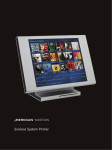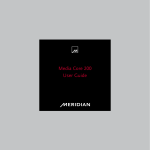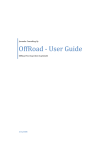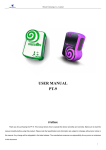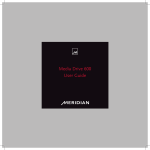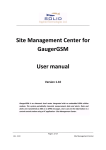Download Sooloos Crestron® Module Guide
Transcript
Sooloos LLC 110 Grene Street, Suite 608 New York, NY 10012 tel: 1.866.606.0333 Sooloos Crestron Module Guide ® Overview This Crestron module will control a Sooloos system using any 2 - Series Crestron processor with Ethernet capability. Each instance of the module will control one audio zone of a Sooloos system. The intended use of this module is for display on a Crestron touch panel. The module provides standard transport controls as well as a browsing interface which allows navigation and selection of media within the Sooloos system. Hardware Requirements •Crestron 2-Series processor w/ Ethernet capability Table of Contents: •Sooloos Source 1. Overview •Ethernet connectivity between Crestron processor and Sooloos Source 2. Module Connection •Windows PC with Microsoft .NET 2.0 connected to Ethernet network with Sooloos system ® ® Software Requirements •Crestron VT Pro-e v3.8 or greater •Crestron SIMPL™ Windows® •Sooloos DumpZoneIDs utility (included with module) 3. Finding Zone Identifiers 4.Zone Selection Behavior 5.Touch Panel Connection 6.External Program Integration Required Installation Information 7.Page Selection Behavior •Sooloos Source IP address 8. Module Glossary •Sooloos zone identifier (see pg. 2) Network Information The Crestron processor must be configured to access the Sooloos Source either via IP address or by host name if a name server is being employed. For most installations, it is suggested to configure the Sooloos Source with a static IP address. Standard module operation requires access from the Crestron processor to TCP/IP port 9011 on the Sooloos Source IP address. Dynamic graphics support for cover art requires access from the Crestron processor to TCP/IP port 80. All cover art is served from the Sooloos Source and the Crestron processor does not need to access the Internet. All Sooloos components require access to the Internet. © 2008 Sooloos LLC Page 1 Sooloos Crestron Module Guide ® Sooloos LLC 110 Grene Street, Suite 608 New York, NY 10012 tel: 1.866.606.0333 Module Connection The Sooloos Media Server module is a SIMPL+® module that can be added to any SIMPL program. Drag the Sooloos Media Server module into the SIMPL program and set the ip_address parameter to the IP address of the Sooloos server. This IP address is found on the Information page located on the home screen of the Sooloos Control:One™. After adding the module to the program, double-click to edit its parameters and joins. One instance of the module will be needed for each independent touch panel which requires access to the Sooloos system. Multiple touch panels can share the same module, but their displays will be synchronized and will not allow independent browsing. © 2008 Sooloos LLC Page 2 Sooloos Crestron Module Guide ® Sooloos LLC 110 Grene Street, Suite 608 New York, NY 10012 tel: 1.866.606.0333 Finding Zone Identifiers A standard Sooloos Source contains five discreet zones of audio output. The Sooloos module allows for a single instance to control up to five zones by using digital inputs to select the zone. Zones in a Sooloos system are identified by 36 character strings comprising of letters and numbers. Zone identifiers are unique between every zone in every Sooloos system, so the identifiers must be retrieved from the Sooloos installation the module will be connecting to. To retrieve the zone identifiers from a Sooloos system, a Windows based computer must be connected to the same network as the Sooloos system. The Windows computer must have at least Microsoft .NET 2.0 installed in order to run the executable DumpZoneIDs.exe which is included with the Sooloos module. If necessary, the Microsoft .NET 2.0 runtime can be installed by following the instructions here: http://www.microsoft.com/downloads/details.aspx?FamilyID=0856EACB-4362-4B0D-8EDD-AAB15C5E04F5&displaylang=en The DumpZoneIDs executable does not take any parameters and can be run directly from the Windows desktop without opening a command window. The output from the utility will look like this: In the above example, the zone identifier is the 36 character alphanumeric string, a73e9d535cfc-4edd-974b-6918f4932205. This value must be copied to the clipboard and pasted as the desired zone#_id module parameter. © 2008 Sooloos LLC Page 3 Sooloos Crestron Module Guide ® Sooloos LLC 110 Grene Street, Suite 608 New York, NY 10012 tel: 1.866.606.0333 Zone Selection Behavior The Sooloos module will connect to the Sooloos server when the open_connection input is pulsed and will attempt to connect to the first zone#_id module parameter. The Crestron program can switch the zone the module is currently controlling by pulsing the corresponding select_zone# input. If at any time the module can’t connect to the server or the supplied zone identifier is not valid, the zone_valid output will be low. This output is intended to be used to display a subpage in any touch panel project which indicates to the user that the touch panel is waiting for the zone to exist before giving the user control. In order to join this output to a subpage, it is necessary to negate it by using a NOT symbol. The resulting zone_not_valid output from the NOT symbol can be used as the subpage join in the VT Pro-e project. For basic installation, where one touch panel uses one module instance to control one zone, the select_zone# digital inputs should be set to 0, the zone1_id module parameter should contain the zone identifier, and all other zone#_id module parameters should be commented out. The Crestron program can switch the active zone by pulsing a select_zone# input high. After switching to controlling the new zone, the module will update its relevant outputs with the currently playing song information for the new zone. The zone#_id module parameters do not correspond to the physical zone order on any Sooloos device. This is done to allow the maximum flexibility in configuring touch panels. Crestron programmers can decide up to 5 zones out of any total number that one physical touch panel can control. © 2008 Sooloos LLC Page 4 Sooloos LLC 110 Grene Street, Suite 608 New York, NY 10012 tel: 1.866.606.0333 Sooloos Crestron Module Guide ® Touch Panel Connection Once the Sooloos module has been properly connected to a TCP/IP Client which connects to a Sooloos Source, the module can be connected to a touch panel instance which will control it. Sooloos offers pre-built VT Pro-e projects which come fully assembled with branded graphics. Each template provides a navigational button which Crestron programmers should use to bring the user back to rest of their Crestron control program when clicked. In addition, the volume controls (up/down), mute, and volume level are intended to be connected by the Crestron programmer to the volume controls the Crestron panel would normally control. The Sooloos itself does not allow for volume modification within the device. Volume should be controlled within the external sound system to which the Sooloos is connected. After selecting the appropriate touch panel which will control the Sooloos module, add it to the SIMPL program. The example Sooloos program contained with each available VT Pro-e project shows how to configure the touch panel joins for proper module behavior. Since join numbers may change in real-world integration projects, it is the integrator’s responsibility to properly connect all joins documented by each VT Pro-e project to the appropriate joins on the Sooloos module. Failure to do so will cause the touch panel project to behave abnormally. Sooloos aims to provide high quality Crestron touch panel templates that are graphically intensive and aim to have the same general theme as the Control:One. There are currently a number of pre-built projects which are in common touch panel resolutions (800x600, 320x240, 240x320, etc) which cover a large range of Crestron touch panel products. If there is a touch panel resolution which does not have a custom Sooloos project available, please contact Sooloos so that we may generate the appropriate project and make it available to all integrators. © 2008 Sooloos LLC Page 5 Sooloos Crestron Module Guide ® Sooloos LLC 110 Grene Street, Suite 608 New York, NY 10012 tel: 1.866.606.0333 External Program Integration Each VT Pro-e template project contains both volume controls and a special green Crestron Home button. It is intended that the green home button be used to bring the user back to the main page of their control program. If the touch panel is only being used to control the Sooloos, the home button can be omitted. The available volume controls are volume up/down buttons and a mute toggle button. It is intended that the integrator tie these buttons into the main volume control that the Crestron system controls. There is no volume control on the Sooloos device itself. In addition to handling these button clicks and providing the volume_muted feedback, an analog volume_level must be supplied to the button between volume up/down buttons to properly display the volume ramp. The analog value must be between the values 0d (completely silent/muted) to 18d (100% volume). © 2008 Sooloos LLC Page 6 Sooloos Crestron Module Guide ® Sooloos LLC 110 Grene Street, Suite 608 New York, NY 10012 tel: 1.866.606.0333 Page Selection Behavior The Sooloos module controls three logical pages of data which every touch panel project should implement. •Now Playing Page The “Now Playing” page is where the system transport controls live. These allow the user to pause, play, stop, change to the next or previous track, etc. The “Now Playing” page is displayed when the page_transport output is pulsed high. •Browse Page The “Browse” page is where the system allows the user to navigate through the various data within the system and to perform actions on the data. The module refers to the data displayed on this page as items within the various join names. Data is represented generically so that the user can use the same interface for selecting songs, adding a playlist to the queue, deleting a collection, swimming within a genre, or any other action the server exposes now and in the future. For each data item, there are potentially actions which can be performed on that item, or the item itself can be selected. Selecting an item is referred to as refining in the join nomenclature. The module instructs the touch panel what state each item is in (e.g. does not exist, exists, exists with actions) so that the appropriate interface can be displayed to the user. This state is in the form of analog joins named item#_button_state which is used in the Sooloos VT Pro-e projects to directly control button modes. The “Browse” page is displayed when the page_browse output is pulsed high. •Confirm Subpage The “Confirm” page is used by the module whenever there is an action on an item which requires confirmation due to its potential for unwanted side effects or loss of data (e.g. deleting a playlist). The “Confirm” page is temporarily displayed whenever the page_confirm output is pulsed high. When this output is high, the confirm_yes or confirm_no input is used to dismiss the page and re-raise the page_browse output high. This subpage can be shown over the “Browse” page. The module will only ever pulse page_confirm if page_browse was the last page to be pulsed high. •Zone Waiting Subpage The “Zone Waiting” subpage is intended to be displayed to the user whenever the zone_valid output is dropped low. This indicates that the module lost connection to the Sooloos server for some reason. After reconnecting, the zone_valid output will be raised high again and the subpage should be hidden. It is recommended that the subpage simply be a black background full-screen subpage stating “Waiting for Sooloos Zone…”. This subpage can be shown over the “Now Playing” page. The module will always pulse page_transport high prior to lowering zone_valid. In order to join the zone_valid output to a subpage, it is necessary to negate it by using a NOT symbol. The resulting zone_not_valid output from the NOT symbol can be used as the subpage join in the VT Pro-e project. © 2008 Sooloos LLC Page 7 Sooloos LLC 110 Grene Street, Suite 608 New York, NY 10012 tel: 1.866.606.0333 Sooloos Crestron Module Guide ® Module Glossary Module Parameters LEGEND: DIGITAL ANALOG STRING ip_address The IP address of the Sooloos Source. This IP address is available from the Information page accessible from the home page on the Sooloos Control:One. zone1_id zone2_id … zone5_id The zone identifier strings are 36 character strings which are retrieved using the DumpZoneIDs.exe tool included with the module. Zone identifiers which are not currently being used should be commented out. For proper module operation, at least one zone identifier must be assigned and selected. num_display_items The number of item related outputs to use. This value is used to control the number of display items which will fit in the current touch panel resolution. Up to 16 items can be displayed at once by a single module. (Valid range: 1d-16d) max_item_name_length This number indicates the maximum number of characters to display in any one given item name. This is provided mainly for compatibility reasons with older touch panels which have strange behavior if text exceeds the available on-screen space. By default, this parameter is set to 0d, which indicates there is no maximum length. (Valid range: 0d-127d) Module Outputs LEGEND: DIGITAL ANALOG STRING connected Indicates the module is currently connected to the Sooloos system specified in the ip_address module parameter. If open_connection is pulsed and this output is not raised high, it could indicate the module has been given an invalid IP address for the Sooloos system, the Sooloos server is currently powered off, or there is a network connectivity problem. zone_valid Indicates the currently selected zone is valid. When low, touch panels should display a full screen subpage stating “Waiting for Sooloos Zone…”. No module outputs are valid while this join is low. page_transport Pulsed high when the “Now Playing”, or transport, page should be displayed to the user. © 2008 Sooloos LLC Page 8 Crestron Module Guide - Module Glossary ® Sooloos LLC 110 Grene Street, Suite 608 New York, NY 10012 tel: 1.866.606.0333 page_browse Pulsed high when the “Browse” page should be displayed to the user. page_confirm Pulsed high when the “Confirm” subpage should be displayed to the user. This join will only be raised high from the “Browse” page, so it can be implemented as full screen subpage of the “Browse” page. No module inputs other than confirm_yes or confirm_no should be used while this join is high. playing Indicates the current active song in the play queue is playing. paused Indicates the current active song in the play queue is paused. stopped Indicates the current active song in the play queue is stopped. shuffle_enabled Indicates the play queue has shuffle enabled. This should be used as the digital feedback for a shuffle button. loop_enabled Indicates the play queue has loop enabled. This should be used as the digital feedback for a loop button. swim_enabled Indicates the play queue is currently swimming. This should be used as the digital feedback for a swim button. From the transport controls, swim can only be disabled once it has been enabled by another client or via the “Browse” page interface. playing_elapsed The elapsed number of seconds in the current active song in the play queue. The value will be zero if there is no current active song. playing_elapsed_pct The elapsed time of the current active song in the play queue represented as a percentage scaled from 0d-65535d. playing_total The total number of seconds in the current active song in the play queue. The value will be zero if there is no current song. Join directly controlling the mode of any play/pause momentary button. play_pause_button_ state © 2008 Sooloos LLC Values: 0 – Play/pause button is disabled 1 – Play state is active 2 – Pause state is active Module Glossary | Page 9 Crestron Module Guide - Module Glossary ® Sooloos LLC 110 Grene Street, Suite 608 New York, NY 10012 tel: 1.866.606.0333 Join directly controlling the mode of any stop momentary button. stop_button_state browse_back_button_ state browse_page_up_button_state browse_page_down_button_state Values: 0 – Stop button is disabled 1 – Stop button is enabled Join directly controlling the mode of the “Browse” page back or return navigational button. Values: 0 – Back/return button is disabled 1 – Back/return button is enabled Join directly controlling the mode of the “Browse” page up button. Values: 0 – Page up button disabled 1 – Page up button enabled Join directly controlling the mode of the “Browse” page down button. Values: 0 – Page down button disabled 1 – Page down button enabled zone_name The name of the currently selected zone. This is not displayed on touch panel projects which have limited space. playing_album The title of the album of the current active song in the play queue. This string value will be a blank string if there is no current. playing_artist The name of the artist of the current active song in the play queue. The string value will be a blank string if there is no current song. playing_song The title of the current active song in the play queue, or the text “No Currently Playing Song” if there is no current song. © 2008 Sooloos LLC Module Glossary | Page 10 Crestron Module Guide - Module Glossary ® Sooloos LLC 110 Grene Street, Suite 608 New York, NY 10012 tel: 1.866.606.0333 playing_url The URL which should be used as a dynamic graphic serial join to retrieve the current song’s album cover. The string value will be a blank string if there is no current active song or the current active song does not have an album cover. Use of this output requires a Crestron touch panel capable of dynamic graphics (e.g. TPMC-8X, TPS-12G-QM). confirm_question The question which should be displayed to the user when the page_confirm output is pulsed high. items_title The display title for the current list of data items. This string provides context to the user indicating what the data items pertain to (e.g. songs in an album, years in a genre). This is not displayed on touch panel projects which have limited space. item_button_state[1] item_button_state[2] item_button_state[3] item_button_state[4] item_button_state[5] … item_button_state[16] item_name[1] … item_name[16] © 2008 Sooloos LLC Join directly controlling the mode of buttons corresponding to the data items on the “Browse” page. Each item has potentially both a button to navigate to the “actions” for each item as well as a button to select or refine each item itself. The same state can be used for both buttons to select the appropriate graphical display. Values: 0 – Item is not currently active 1 – Item is active, does not have actions 2 – Item is active, has actions String names for the current data items being browsed. These values should be displayed to the user as the indirect button text for each individual item on the browse page. Module Glossary | Page 11 Sooloos LLC 110 Grene Street, Suite 608 New York, NY 10012 tel: 1.866.606.0333 Crestron Module Guide - Module Glossary ® Module Inputs LEGEND: DIGITAL ANALOG STRING open_connection When pulsed high, instructs the module to connect to the Sooloos system specified in the ip_address module parameter. This input should be pulsed high during program startup. It is recommended that the Crestron processor stay connected to the Sooloos system at all times to avoid user delays when switching to control the Sooloos system. If multiple modules are being used within a single processor, it is recommended to stagger their startup by using a Stepper symbol. The module will automatically re-connect to the Sooloos server in case of disconnection caused by any reason other than pulsing close_connection high. close_connection When pulsed high, instructs the module to close the current connection to the Sooloos system. This input is not normally used in programs where the Crestron processor stays connected to the Sooloos system. select_zone[1] select_zone[2] … select_zone[5] When pulsed high, instructs the module to switch to controlling the Sooloos zone indicated by the corresponding zone#_id module parameter. By default, the module controls zone1_id after successfully connecting to a Sooloos system. Once pulsed high, the module will request the information from the server for the corresponding zone#_id module parameter and will re-populate the relevant module outputs. If the corresponding zone identifier is not valid, the zone_valid output will be pulled low. show_transport When pulsed high, instructs the module to switch display to the transport page. This action modifies internal state and pulses page_transport high. Pulsing this input while the module is currently waiting for confirm_yes or confirm_no to be pulsed has the same effect as first raising confirm_no. show_browse When pulsed high, instructs the module to switch display to the browse page. This action modifies internal state and pulses page_browse high. Pulsing this input while the module is currently waiting for confirm_yes or confirm_no to be pulsed has the same effect as first raising confirm_no. © 2008 Sooloos LLC Module Glossary | Page 12 Crestron Module Guide - Module Glossary ® Sooloos LLC 110 Grene Street, Suite 608 New York, NY 10012 tel: 1.866.606.0333 play When pulsed high, instructs the server to play the current song. This action is only valid if either the paused or stopped outputs are high. play_pause When pulsed high, instructs the server to toggle the current playing or paused state. After being raised high, the module will update the playing, paused, and stopped outputs to reflect the appropriate state. The play_pause_button_state output should be used as the analog join controlling button modes for any button triggering this join. stop When pulsed high, instructs the server to stop the current song. This action is only valid if either the paused or playing outputs are high. The stop_button_state output should be used as the analog join controlling button modes for any button triggering this join. next_track When pulsed high, instructs the server to advance the current song to the next track in the play queue based upon the current play queue settings. prev_track When pulsed high, instructs the server to advance the current song the previous track in the play queue based upon the current play queue settings. shuffle_toggle When pulsed high, instructs the server to toggle the current shuffle setting of the play queue. The shuffle_enabled output reflects the current state and should be used as button feedback for any button triggering this join. loop_toggle When pulsed high, instructs the server to toggle the current loop setting of the play queue. The loop_enabled output reflects the current state and should be used as button feedback for any button triggering this join. swim_disable When pulsed high, instructs the server to disable the swim setting of the play queue if it is currently enabled. If swim is not enabled, there is no effect. The swim_enabled output reflects the current state and should be used as button feedback for any button triggering this join. © 2008 Sooloos LLC Module Glossary | Page 13 Crestron Module Guide - Module Glossary ® Sooloos LLC 110 Grene Street, Suite 608 New York, NY 10012 tel: 1.866.606.0333 browse_back When pulsed high, instructs the module to return to the previous level of data browsing (e.g. return from Albums to Artists). This input is only valid while the browse_back_button_state has a value of 1. browse_page_up When pulsed high, instructs the module to scroll up one page of data within the current level. This input is only valid while the browse_page_up_button_state output has a value of 1. browse_page_down When pulsed high, instructs the module to scroll down one page of data within the current level. This input is only valid while the browse_page_down_button_state output has a value of 1. confirm_yes After the page_confirm output has been pulsed high, this input is used to signal that the user has confirmed the question posed by the confirm_question string output. After being pulsed high the module will perform the necessary action and pulse the page_browse output to once again show the browse page and return to displaying the previous level of data. confirm_no After the page_confirm output has been pulsed high, this input is used to signal that the user has declined the question posed by the confirm_question string output. After being pulsed high, the module will pulse the page_browse output to once again show the browse page. item_refine[1] item_refine[2] item_refine[3] … item_refine[16] When pulsed high, instructs the module that the user has selected one of the currently displayed data items. The input is only valid if the corresponding item_button_state[#] has a non-zero value. Pulsing an item_refine[#] input will display the next level of data for a particular data item. Once no longer viewing the root level of data, the browse_back_button_state output will be set to 1, indicating that the browse_back input is valid to be used to return to the previous level of data. When the refined data item is an action (e.g. Play Now), the module will automatically return to displaying the previous level of data. © 2008 Sooloos LLC Module Glossary | Page 14 Crestron Module Guide - Module Glossary ® item_actions[1] item_actions[2] item_actions[3] … item_actions[16] Sooloos LLC 110 Grene Street, Suite 608 New York, NY 10012 tel: 1.866.606.0333 When pulsed high, instructs the module that the user has selected to view the actions corresponding to a currently displayed data item. The input is only valid if the corresponding item_button_state[#] has a value of 2, indicating actions are available. Pulsing an item_refine[#] input on a leaf data item (e.g. a song) has the same effect as pulsing the corresponding item_actions[#] input. Files Sooloos Media Server.usp Sooloos Media Server SIMPL+ module Sooloos Media Server.ush Sooloos Media Server SIMPL+ module header DumpZoneIDs.exe Utility for determining zone identifiers for module parameters Support Sooloos LLC 110 Greene Street, Suite 608 New York, NY 10012 9:00am – 7:00pm EST, Monday–Friday Domestic: (866) 606 - 0333 International: +1 (646) 205 - 9276 © 2008 Sooloos LLC Module Glossary | Page 15















